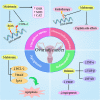Melatonin is a potential inhibitor of ovarian cancer: molecular aspects
- PMID: 30914056
- PMCID: PMC6434863
- DOI: 10.1186/s13048-019-0502-8
Melatonin is a potential inhibitor of ovarian cancer: molecular aspects
Abstract
Ovarian cancer is one of the most common causes of morbidity related to gynecologic malignancies. Possible risk factors are including hereditary ovarian cancer, obesity, diabetes mellitus, alcohol consumption, aging, and smoking. Various molecular signaling pathways including inflammation, oxidative stress, apoptosis and angiogenesis are involved in this progression of ovarian cancer. Standard treatments for recently diagnosed patients are Surgery and chemotherapy such as co-treatment with other drugs such that the exploitation of neoadjuvant chemotherapy is expanding. Melatonin (N-acetyl-5-methoxy-tryptamine), an endogenous agent secreted from the pineal gland, has anti-carcinogenic features, such as regulation of estradiol production, cell cycle modulation, stimulation of apoptosis as well as anti-angiogenetic properties, anti-inflammatory activities, significant antioxidant effects and modulation of various immune system cells and cytokines. Multiple studies have shown the significant beneficial roles of melatonin in various types of cancers including ovarian cancer. This paper aims to shed light on the roles of melatonin in ovarian cancer treatment from the standpoint of the molecular aspects.
Keywords: Anti-angiogenetic properties; Anti-inflammatory activities; Melatonin; Ovarian cancer; Signaling pathways.
Conflict of interest statement
Ethics approval and consent to participate
This study was considered exempt by the KAUMS Institutional Review Board.
Consent for publication
Not applicable.
Competing interests
The authors declare no conflict of interest.
Publisher’s Note
Springer Nature remains neutral with regard to jurisdictional claims in published maps and institutional affiliations.
Figures
References
Publication types
MeSH terms
Substances
LinkOut - more resources
Full Text Sources
Medical


